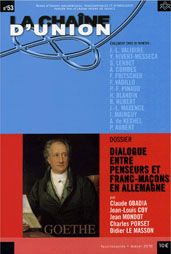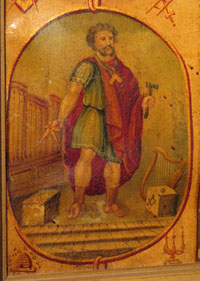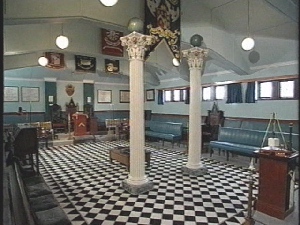Published by two GODF journals, the first version by Humanism in 2000; the second, reproduced here with a few revisions, by The Chain of Union, Paris, No. 39 2007.

Man has three ways of understanding the world:
- Rational thought
- Symbolic thought
- Artistic thought
He has developed three corresponding families of languages. These three types of thought are of equal importance, even if they do not play the same role and do not function in the same way, and even if, in some cultures, the balance between these three modes of thought is uneven.
1) Rational thought:
In our civilisation, spoken language seems more "natural" than symbolic language. It is more highly developed and altogether adequate to instil doubt about the usefulness of other languages. Often we think that words not only have the ability to designate, but also possess the evocative power of symbols. Thus, they could replace symbolic languages at least in part. This is not the case, but to prove that they represent two different mental approaches – complementary and always current – we must start by analysing the nature of words, the mechanics and functions of spoken language and then compare the language of symbols and that of art that many "rationalists" discredit in taking as mere "decoration."
When man creates words, he begins by abstraction in order to assign the same sign (the same word) to a family of phenomena. He retains only certain features of these phenomena and the means for a sound or other sign (hieroglyph, codified gesture, mathematical "symbol" and so on1) that is most often quite arbitrary and unrelated to what it designates.
Thus, the single word "plant" designates an incredible diversity of living things. All living beings not belonging to this category can be placed together under a different single name: "animal." Both sets refer to "living beings" or "living matter" as opposed to "dead matter." These terms have specific functions, but we must not forget that no "plant", no "animal" or no "mineral" exist as such.
Words and other signs can be arbitrary because they are not essential to evoke what they name. Thus, they may be composed of any assemblage of sounds or other materials. Yet they often imitate, or somehow insinuate, what they mean. With onomatopoeia, the relationship with their content is obvious, but such words are quite few and far between. Other words seem suggestive because they were created from words that classify similar phenomena. This approach is more economical and aids in memorisation. Thus, an "earthling" lives on "earth," a "miner" is someone who extracts "minerals" at the bottom of a "mine," a "tourist" is a person who takes a brief "tour" and then goes away. These multiple idea associations give words a certain evocative power that approximates symbols, without being confused with them.
The ability to bring together whole families of phenomena under one and the same name is the raison d'être of words and languages they constitute.

Certainly, words may also be attributed to singular realities: then they are called "proper names." But if every being, every thing, every action had to bear its own proper name, and nothing but a proper name, man could perceive them but not use them in relation to other realities, or use them to communicate with other people. He could create poetry, but we would not know either science or philosophy.
Words are used to identify, collect, sort and classify the phenomena they refer to, and then to express their relationships. They also allow the attribution of values, by adding them or removing them and creating hierarchies between them. They offer one way to "understand" man and his world... But beware! If words can be functional in the processing of things and beings as more or less abstract entities, mathematical values in a way, they can also lead to incorrect reasoning, which, when translated back into reality, can be dangerous.
If we argue, for example, that what is complex is superior to what is simple, we can deduce that a man is better than a lark. We have already sacrificed many beings due to this type of reasoning and, by drastically reducing the biological diversity on earth, we begin to threaten the survival of our own species.
Spoken language is governed by rules of grammar and logic, which, in principle, should help us avoid such fallacies. At the same time, we can and must look at all reasoning through "objective" reality, which also should allow us to avoid errors. But what is "objective" reality? We see everything through the filter of words and convey our impressions through the equally abstract sieve of grammar and logic, further stretching their connection with the experience. Moreover, the complexity of grammar and logic makes them difficult to master. We quickly get lost in labyrinths designed to lead to erroneous conclusions that may be as grotesque as those cited in the previous paragraph.
By relying exclusively on sign language and the logic that governs it, we can put forth absurdities that seem reasonable, but are in fact suicidal. For example, some would entrust power to chosen men based on their intelligence quotient (IQ) alone. At first glance, it is tempting to be governed by the most "intelligent" men. However, intelligence is not everything, and shouldn’t we remember that IQ, which is supposed to measure it, was invented by the U.S. Army to evaluate some – and only some – abilities, including quick decision-making? If governments were formed following this single criterion, the result could only be disastrous since the selection process does not take into account the complexity of individuals, societies, the earth, the universe and the process lacks the patience to study them. Moreover, the threatening racial theories of people like Hitler would quickly find a new wellspring of inspiration.
Language is the best and the worst of all things, according to Aesop. We should not expect more than it can give. A French proverb states, Even the most beautiful girl in the world can only offer what she has... ("Même la plus belle fille au monde ne peut offrir que ce qu'elle a...") Basically, words are nothing more than an accounting tool. That is why they lend themselves so well to conversion into computer codes, where they become a series of "zero" and "one", of "yes" and "no" signals. They are useful, but we could challenge them with the same virulence, or the same contempt that some show over languages comprised of symbols.
Words are arbitrary and human societies have developed countless languages that despite their diversity are all homogeneous coming from the same source material. Words are always articulated sounds (they remain the same when they are written); the language of hearing impaired persons is composed entirely of gestures; geometric "symbols" are always designs (we should say geometric "signs"); and all hieroglyphs have the same pictorial characteristics. Moreover, spoken languages are structured following the same patterns and governed by laws so similar that the linguist Chomsky presupposed the existence of a universal grammar and heritage.
Sign languages and the rules that manage them are well suited to the human brain. By simplifying and ordering the senses’ perceptions, they enable grasping the world in a way that seems to correspond to the structure of the brain. They help the brain better memorise the impulses it receives from our senses. But sign languages are not necessarily the only way our brain has to process this information.
2) Symbolic thought and its relation to rational thought:
If sign languages combine these phenomena and evaluate the relationships between them, symbolic languages cover the fields of human experience.
Consider the example of Masonic symbolism. The purpose of Masonry is the initiation of the individual; its symbolism follows all paths of initiation from antiquity to the present2.
The content of each field of experience gives shape to its symbolic expression:
In finding that initiation signifies reshaping of the individual and the construction of society, we understand why Masonic symbolism strongly refers to the art of builders: the pyramids, the Temple of Solomon and Christian cathedrals.
If words simplify, sort, classify – and divide – symbols bring together and order disconnected experiences. They "bring together what is scattered." ...

Symbolic systems such as the Freemasons’ include fields of experience that are too large to be expressed in a comprehensive manner. This is not their goal. I will return to the question of these systems’ meaning, but in the meantime, it should be noted that their tools, the symbols, are always open. They imply more than they define.
If words combine identical phenomena through certain features, symbols assemble elements that may seem quite disparate. They do not necessarily resemble each other, but are linked by a chain of causalities.
Thus, the word "temple" includes all buildings for Protestant worship, while the Masonic "Temple" symbol refers to other realities and ideas relating to the history of civilisation, philosophy, architecture, astronomy, geometry, and so on. The "Masonic Temple" symbol does not make one think only of the place where a group of Freemasons meets, but also of land, religion, the organisation of human societies, and more.
"Here, everything is symbol," said Goethe about the Masonic Temple.
The Masonic lodge is a three-layer "scale model" of the universe, humanity and man. It is a symbolic representation of reality, a condensed image whereby each element has the power to evoke countless other missing parts. .
I have said Masonry contains the initiation pathways of humanity since its origins, but now should clarify that, in fact, through its symbols, Freemasonry primarily refers to European and North African civilisations. It has evolved within them and closely reflects them. Nevertheless, through study we quickly realise that despite its Western geographical origins, the Masonic model also includes many references to the experiences and thoughts of the peoples of Asia and the Americas. This shows that for millennia, information flows more freely than we believed, before aircraft and cybernetics came into existence. This also suggests that men in all ages and all countries are more alike than their cultures suggest. In any case, that is what they wanted us to signify to the founders of modern Freemasonry3.
Unlike a word, whose form is arbitrary, a symbol contains certain features of the reality to which it refers.
By continuing to use the previous example, I can say that if the word "temple" has nothing to do with what it designates, the "temple" symbol may be expressed by its location, picture or another object that evokes a sacred space.
While sign languages are homogeneous, symbol languages can be heterogeneous, composed of very diverse elements:objects, words, graphics or sounds, even tastes, fragrances, tactile elements. Thus, at a Masonic initiation, the recipient drinks a bitter beverage, during the celebration of St. John the Freemasons burn fragrant plants; their posture known as "in order" includes a soothing gesture of the hand placed over the chest (one of the chakra in Kundalini yoga, "the junction of energy channels"), a different perspective brings to mind the disturbing Japanese hara-kiri, and so on. Diversity and heterogeneity of symbols are destined for all of the senses.
In this case, the left side of our brain processes information provided by the language of signs, while senses’ contributions (and undoubtedly also the contributions of art) are processed on the right side. It seems that in men ("males"), particularly those who study, organise and lead, the left side of the brain is more developed than the right side. Using images, symbolism involves the right side of the brain and thereby restores balance between words and logic on the one hand, and feelings, ideas and intuition on the other. Is this the reason behind the revival of Masonry in Europe during The Age of Enlightenment and, in the event that it were, the scientists of that time in particular?4
 Words are not universal and they are born, grow old and then die. Conversely, symbols pass from civilisation to civilisation without any concern for time or geography.Words are localised in time and space, while symbols are timeless and universal. They represent a powerful "spiritual Esperanto." Of course, no human creation is everlasting and symbols perish, too. But if they sometimes expire with the community that used them, they usually disappear in a paradoxical way: they lose their value as a symbol when they have acquired a specific meaning that can be fully expressed in words, that is to say, after being transformed into signs.
Words are not universal and they are born, grow old and then die. Conversely, symbols pass from civilisation to civilisation without any concern for time or geography.Words are localised in time and space, while symbols are timeless and universal. They represent a powerful "spiritual Esperanto." Of course, no human creation is everlasting and symbols perish, too. But if they sometimes expire with the community that used them, they usually disappear in a paradoxical way: they lose their value as a symbol when they have acquired a specific meaning that can be fully expressed in words, that is to say, after being transformed into signs.
Is this one of the reasons for removing the reference to the Great Architect of the Universe in the GODF rites in the late 19th Century?
At that time, this expression had become synonymous with the Christian God. It had lost its initial power. A century later, churches had taken the road of ecumenism and, coincidentally, the rites that continued to refer to the Great Architect again showed a partially undetermined meaning. Today, the Great Architect may be God, Jehovah, Muhammad, Buddha or any other principle that expresses faith in a single source of the universe. This "source" is no longer defined with dogmatism and, hence, the Great Architect symbol could possibly regain acceptance even in "secular" obediences.
That said, modern science suggests new hypotheses through which the universe no longer has one source, but several. According to this perspective, the Great Architect should include polytheistic beliefs. Are traditional Freemasons capable of taking that step?
If words are composed of more complex entities by following abstract laws, but are defined and direct towards precision, towards a single meaning, symbols come together freely and seek to encourage the association of ideas without boundaries.
Grammatical laws are constantly changing, while the collection, ordering and reading of symbols are governed by ancient rites that change but slowly.
All this explains why it is not easy to learn a language alone, without ever speaking with someone who has mastered it. It is even more difficult, if not impossible, to learn system of symbols outside the community from which it originated and which it serves. That’s why it is impossible to understand Freemasonry only by reading books.
Regarding words, it is fairly easy to determine if they belong to a given language or not, to try and memorise them or, conversely, not pay attention to them. Even if they are in constant evolution, languages contain a fixed number of words that may be included in dictionaries. And grammar is a sum of defined rules that can be learned.
Symbols themselves are heterogeneous and their number is unlimited. Anything may become a symbol in any symbolic language. The same "object" can serve as a symbol in many systems. Moreover, symbols act upon all of our senses and it is not enough to describe them. Lastly, no "grammar" rules exist for symbolic languages.
Ricouard wrote that if symbols could not be fully described and thus transmitted to others, they were nonetheless a common and indivisible good for the group that used them. Here is where a good part of what is called the "Masonic secret" comes from:
By promoting intuitive thinking, symbols facilitate overcoming limits that are personal, social, past or present, and give the impression of understanding what is shared by all men and all civilisations.
By constantly bearing in mind the complete evolution of mankind and the universe, symbolism provides a dazzling powerful sensation of knowing all, understanding all and mastering all. Thus, symbolic languages lead to belief in the existence of absolute "truth" and encourage seeking it out. And they reassure, intoxicate and excite to the extent of sometimes creating enlightenment, revelations or "satori." It's not for nothing that all religions use symbols in the way that initiation groups tend to use light.

All of this is eminently useful on a personal level, as well as at a social level. Humanity has already experienced in the "flesh" an almost unlimited number of lifestyles and knowledge, accumulated through the ages and civilisations, and that contain the solutions to the vast majority of our problems. Through the translation of this knowledge into a symbolic language, our ancestors’ experiences emerge from the background and fill the "canvas" with our own lives. This enables us to better support their whims, and more easily imagine the path of our destiny – and undoubtedly to influence it. Can we still create order out of this mass of knowledge that otherwise would quickly become anguishing if it must also be stored in our memory.
A symbol is an excellent memory aid. Since it does not require memorisation of the entire battery of symbols, it occupies little space in the brain, but by its nature refers to a high number of mental representations. In speaking to all our senses the symbolic system works in three dimensions. Its evocations are much larger than those of words. Thus a symbol allows placing side-to-side our perceptions, feelings, impressions, past and present knowledge, concrete and abstract knowledge, and close or dispersed knowledge that otherwise would not be encountered. Always this desire to "bring together what is scattered"... And it enables arranging them in a way other than that of sign languages with their syntax and logic.
Memorisation using symbols is largely virtual. Symbols allow establishing links between all that man knows, perhaps between all that exists across space and time, but the knowledge is only potential for the vast majority of these relationships. This is enough to have an intuition of the unity of the universe, the interconnectedness of beings, the needed brotherhood of men. It also helps us to recognise the relativity of truths that were discovered through rational thought.
Symbols are pieces of a puzzle. Their meanings can be discovered from the experience of everyone, with the help of the community to which they belong and its rites. Difficulty in reading symbols is the price to pay to embrace the individual, humanity and the universe in both their temporal and spatial senses.
The power of symbols is directly proportional to the knowledge of the person who meditates. That is why we can say that by observing a symbol, one "contemplates his own path." Through symbols, one may review his own past and his roots, then return to the present by better understanding who he is. By starting with oneself, one advances towards others.
An understanding of symbols is constructed and each community member must process them in creative ways. We are in the realm of art - of Royal Art... While walking in a world of symbols, man travels from simple to complex, from present to past, personal to the general – or vice versa.
This need to construct one’s own symbolic language by linking what we know with what we sense, in patiently building, stone by stone, a pyramid of knowledge, may be another answer to the question of knowing why Masonic language includes so many references to the builders’ trade.
The open nature of symbols and an inability to decipher their meaning outside of the community from which they are derived corresponds to the metaphor, attached to the word "symbol," "sumboleum" in its original Greek. This word originally meant a stone broken in two that lets members of the same tribe recognise one another, even if they have not seen one another for many years, and even if they have never met. In finding one another, they brought together the two "sumboleum" parts and if they fit together perfectly, it stood as proof of shared belonging.
These two pieces of stone interlocking even insinuated that the "nesting" of their holders was possible. Symbolic languages continue in the same way by allowing men to recognise one other despite the diversity of their bodies, living conditions and cultures. It's not for nothing that the initiation societies are formed by co-optation. These societies are following the saying "birds of a feather flock together."
Half of a symbol that one possesses enables searching for the second half – or the other "halves" – because, in fact, each "half" of a symbol fits perfectly with many others.
At first glance, this assertion is nonsense. In mathematics and geometry, one half cannot have several other halves. However, a stone broken in two to become a "sumboleum" came from another larger stone, which itself was part of another even bigger stone. Both sides of the "sumboleum" were put together by a newly visible break, but since each of the parts is in three dimensions, it could be joined to many other stones, to infinity. Bring together what is scattered...
A propos: If a word can be "revealed," a symbol cannot. In Masonry, the "word," which is a symbol like everything else in Masonry, is lost and in each generation, each Brother must find his own. If the "word" meaning "sign" can be turned into dogma, the symbol cannot be, because its meaning cannot be frozen. Masonic symbolism is an excellent weapon against totalitarian temptation.
I plead for symbols while knowing they are but only one tool. They are the finger that enables pointing out the moon. Never forget the Chinese proverb: "When we showed him the moon, the idiot looked at the finger." But conversely, we really need the finger to show it. Do not despise the finger.
After expressing this enthusiastic opinion about symbolic languages, I would like to issue a warning:
The use of symbols referring only to the past involves the risk systematic conservatism so stagnant that it can be dogmatic. Thus, the unchanging character of Masonic rites arouses some suspicion, awakens fears and provokes controversy. Remaining anchored in the past is reassuring, helpful and rewarding, but for the ritual to fulfil its role completely, it must find a counterweight in the search for new individual and social projects.
A GODF Convent report on 2 September 1992 devoted to Masonic symbolism states, Symbolism remains a tool for the elevation of the spirit. It opens a window into another dimension of reality. It offers a way to express the inexpressible, or instead, to approach it. It is the language of the memory of mankind.
The first three "symbolic degrees" of Freemasonry summarise the entire Masonic territory. From there, other systems can be derived complementing these three degrees and deepening thoughts on metaphysics, the organisation of society or the art of governance (which brings us back to the Royal Art in the literal sense – verbal – of the term). "Blue" Masonry comprises all Masonry, though its "high grades" (in English "sides degrees" parallel degrees) enabling "specialisation," orientation towards one or another of its aspects.
Freemasonry is not merely a symbolic power, but, through its original use of symbols based on a millennium of experience, it has an undeniable power.
3) Artistic thought

Art helps the artist express himself, allowing him to "objectify," to create a reflection of himself (in the form of a painting, poetry, music, theatre) that he can observe. This corresponds to a deep human need and may serve as an efficient kind of self-therapy.
An artist uses materials that have a personal meaning that is difficult for someone else to grasp entirely. But despite this, his creation lets the artist to compare himself to others. Men gather together despite their differences, and every individual can re-experience his work as an expression of his own personality. Thus, in turn, brings them to understand that an artist is like them and vice versa.
An artist creates for himself, but by placing his work before the public sees how others perceive it and that brings him closer to others. He may then attempt to influence their attitude towards him. .
Art enables accepting and being accepted by others, and by having mutual acceptance of one other even if all are unique, foreign and therefore more or less disturbing. "Music soothes the savage breast."
Art lets us discover, or rediscover, all of the facets of human potential, to "vibrantly" be recaptured by the work of an artist and thus to keep them available – as, on another level, sport helps us to maintain the strength of our muscles and other muscles that are not adequately used, or not used at all in our daily lives, but that we may need again if our lifestyles changed.
Lastly, art allows us to test whether or not society is willing to tolerate certain behaviours that are shunned in one situation, banished as aberrant and forgotten, but which may prove useful in another.
For example, modesty, and even sexual hypocrisy, may be useful if fertility exceeds the capacity to feed the resulting children. And, on the contrary, in the event of a declining birth rate, art will be the first means used to encourage any expression of erotic desire. In peacetime, aggression must be curbed, but encouraged in the event of war, etc.
Art contributes to future changes as soon as artists, the public and leaders betray their imminence. No court can decide whether a society is ready to take on such changes in behaviour and no law can enforce them. At serves as both a safety valve for base instincts and a messenger of new relationships between men, and can be a catalyst for such changes.
Art helps to maintain the adaptability of man.
Despite its personal character, the social utility of art is undeniable.
Conclusion:
Artistic languages, preserving human richness in all its diversity, are a form of person-to-person communication, from artist to his audience. ![]()
Art helps an individual to accept his group and harmonise with them with while preserving his individuality. It helps to maintain all of man’s evolutionary capital through the ages, and his present and future ability to adapt to life’s changing circumstances. As such, artistic individualism must be protected in the same manner as biodiversity.
Symbolic languages convey for an individual a collective experience.![]()
They allow him to melt the experiences of his community in his personal alchemist’s athanor and transform them into his own experiences. Thus, he approximates the "collective being" of his group, while at the same time helping to develop the latter by its peculiarity. "If you differ from me, my Brother, far from hurting me, you enrich me."5
Sign languages are a means of communication between groups and an individual.![]()
![]()
In using sign language, man expresses only part of his experience, the part that corresponds to shared experience and can be translated into the system of abstractions resulting there from. Through this, man expresses himself as part of the community with whom he communicates. Thus, he strengthens others and increases his own power and efficiency.
None of these languages in itself is adequate to understand and express all facets of man or society. Art is fundamental for the individual, rational languages are used to organise secular life and make science possible while symbols help build humanity.
However, there are no impassable boundaries between them. Despite their peculiarities they are complementary, and this complementarity is nicely illustrated by the fact that these three types of languages are constructed with the same materials, even if they are used differently.
Our Western society focuses on sign language and imposes its dominance on the entire planet in the name of productivity. This was surely its rationale, but it is a risky approach. There is no reason to question the usefulness of symbolism and we should use it much more as an art.
Peter Bu

1The word "symbol" is used incorrectly when we speak of mathematical signs.
2Initiation, that is to say rites facilitating the transition from childhood to adulthood, the journey from a world where the individual is the centre to a boundless universe where he finds himself just a part of larger groups, exists in all civilisations. They enable each one to learn his place, to set the rules of society and ensure their compliance. While the forms of these rites are different, their content is very similar.
3For proof, read Samuel Noah Kramer History begins in Summer (Flammarion, Paris, 1994).
4A loss of equilibrium between the two parts of our brain costs us dearly, perhaps too much. I cannot explain why I think so here, but it seems to me that because of this imbalance the West is trying to threaten the very existence of life on earth. And it's probably not a coincidence that drug addiction peaked in industrialised countries.
Another more comical, but no less dangerous symptom: In the year 2000, France identified 50,000 fortune tellers and 3,800 priests, which was compared to 70,000 practicing physicians!
5 Quote by famous ''Brother Mason'' Saint-Exupery.
.........................................................................
http://modern-freemasonry.com was created to promote the free exchange of ideas on Freemasonry.
This free-flow of ideas was prevented by 50,000 contributions that had nothing to do with Freemasonry, wanting only to use this site for advertising.
I've cleared all this pollution to enable relevant conversation to resume.
Thanks in advance for your thoughts in the FORUM on topics that interest the Freemasons.






